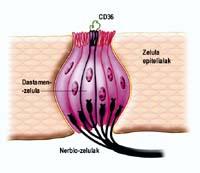Flavor of fat

Earlier scientists believed that our taste cells only distinguished four flavors: salty, bitter, sweet and acid. In the tongue, the receptors of each taste are found in different places: those who perceive the sweet on the tip of the canvas; the lateral and the inferior ones, those of the acid; on the edges, those of the salt; and on the back of the tongue, near the throat, those of the bitter ones.
Later, however, they realized that, in addition to the four basic flavors, in the language there were at least receptors of another: the taste of umami. Protein and fermented foods have a humour flavor, and especially glutamate.
The list of taste receptors has now been further expanded. Researchers at the University of Burgundy in France have found that mice have a fat receptor. Men and women also have this receptor and it is possible that the receiver is key to understanding why some like fat food.
Passion for fat
Researchers from Burgundy have worked with mice and rats in a receptor in adipose tissue: Receiver CD36. CD36 detects fatty acids and is present in fatty tissues and other tissues.
To learn about the presence of the CD36 receptor in the language, the researchers marked with fluorescent red ink the antibodies that stick to the receptor. Seeing that the taste buds appear in red, the doubts were cleared: the tongue also has these fatty acid receptors.

However, the researchers were not there. Mice wanted to know if they used the CD36 receptors of the tongue to detect food fat. For this purpose, mice without receptor grew. Then they were put the traditional menu and junk food, that is, fat food. And, apparently, they were not able to differentiate the difference between both, since they ate equally from one to the other.
With the same test as common mice, the researchers clearly saw what mice preferred: they ate garbage three times more than the traditional menu. Hence it follows that the food with a lot of fat is attractive to the mouse. It has also been mentioned that the same occurs in humans. In fact, 40% of the calories consumed daily in industrialized countries come from lipids, although 25% less is the best for health.
Digestion in progress
In addition to demonstrating the presence of fat receptors in the language and the detection of fatty acids, researchers wanted to know what happens from there.
Apparently, when fatty acids are associated with CD36 receptors, a nerve signal is emitted that produces secretions that digest fats. The same occurs when the sweet receptors are activated, in which case the organism is prepared to digest and use the sugar.
On the other hand, in mice that do not have CD36 receptor this mechanism does not work properly. In humans, the relationship between CD36 receptors and digestion is also clearly seen. In fact, people with a deficit of receptors suffer from metabolic syndrome, among which are excess blood cholesterol, hypertension and the tendency to diabetes.

However, in addition to the language, the CD36 receptor is present in many other cells or tissues, to which different types of molecules are associated. In addition, these associations generate physiological responses of various kinds. For example, within the cell, it participates in the synthesis of triglycerides, while in the cell it influences the oxidation of fatty acids and adipose tissue in the accumulation of lipids.
Against obesity
Considering the number of functions it performs, it does not seem easy to get what some researchers have pointed out. Some have proposed blocking receptors to reduce their passion for fat. It could be a way to fight obesity.
However, the mechanisms of obesity and hunger are very complex and are not yet well known. In addition, it is true that mice in the non-receptor laboratory did not have a special desire to eat fat, but on the other hand, people with few CD36 receptors present metabolic problems. Therefore, to propose such proposals seems to advance too much.
Yes, scientists have seen that not all people have the same number of CD36 receptors in the language. According to them, this can be one of the reasons why some have more taste than other fatty or fatty foods. The researchers intend to deepen this path and, step by step, will release the mousse of taste, appetite and obesity.





